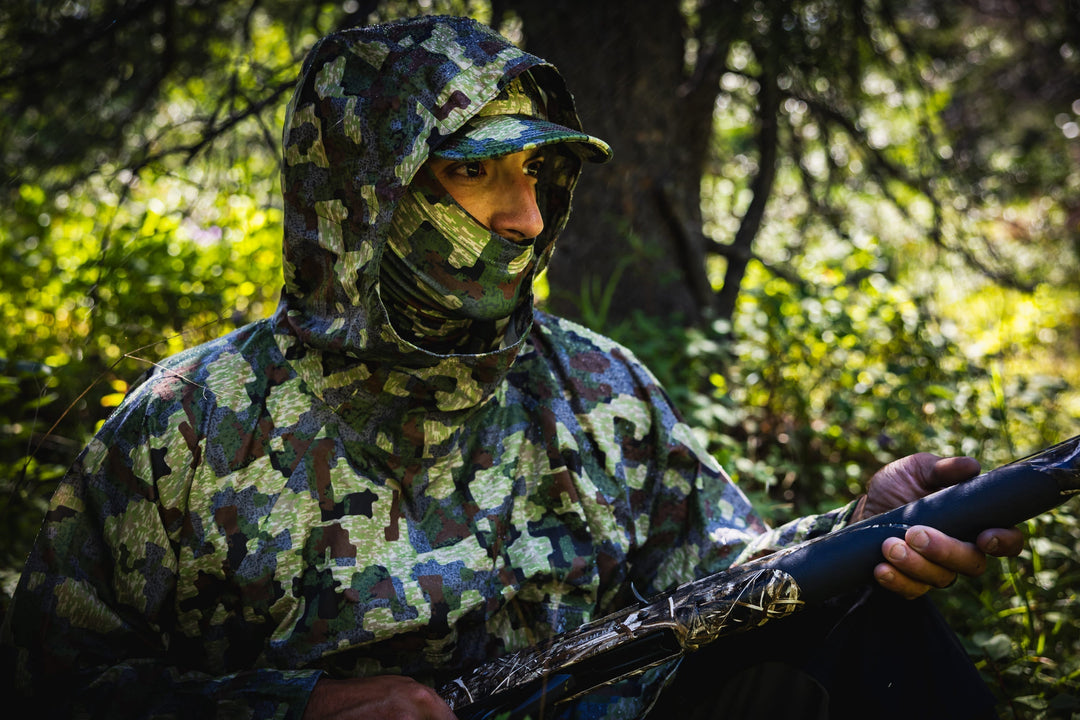FORLOH’s latest apparel uses Insect Shield®, a scentless fabric application that staves off mosquitos, ticks, and other critters for the life of the garment.
Every hunter likely knows the adage: You can fool their eyes and you can fool their ears, but you’ll never fool their noses.
Prey animals’ keen sense of smell is the very reason that FORLOH made scent-blocking the foundation of our Crypsis camouflage technology. But when hunting in places with heavy insects (mosquitos in Alaska, ticks anywhere in the eastern US), hunters face the choice of risking exposure to insect bites and sickness to go odorless or protecting themselves against the bugs with noxious chemical repellents like DEET and likely winding their quarry.
Until now.

FORLOH’s latest warm-weather garment, the Insect Shield SolAir UPF Hooded Long Sleeve Shirt not only keeps the heat and harmful UV rays at bay, it also acts as built-in insect protection. That means outdoorsmen can safeguard themselves from harmful diseases including West Nile virus, Lyme disease, and malaria by simply getting dressed.
The secret to the garment’s protection is Insect Shield’s application of the insecticide permethrin directly to the fabric.
A chemical in a next-to-skin garment might sound like a risky proposition, but permethrin has an excellent safety record dating back decades, with EPA approval for its agricultural use dating to the late 1970s. It is sprayed on produce to keep away the bugs and therefore considered safe for human consumption. Permethrin is the reason you can go into a grocery store and purchase a beautiful head of lettuce without insect holes in the leaves.
Permethrin was formulated for use as a textile application in the 1980s. It is a contact repellant, so as an insect such as a mosquito comes in proximity, the permethrin disrupts the creature’s nervous system and obstructs its ability to feed. At the same time, it has no effect on humans. “This is used on foods, which speaks to just how innocuous it is,” says Rick Hemmerling, vice president of Insect Shield. He cites numerous EPA studies that show zero transfer of permethrin to human skin when used on textiles. It has also been tested and approved in Japan and widely across Europe. “We have gone out of our way to test it. Human safety is our number one concern, even before efficacy.”

Though permethrin has been used in textiles for almost 40 years, Insect Shield’s proprietary application process was the technology breakthrough. Hemmerling helped develop the technology in 2003 for Ex Officio, the company that he founded. Whereas previous applications were sprayed onto the fabric, which provided protection for only four to six weeks, Insect Shield found a way to bond the permethrin to the fabric. By moving a finished garment through a sealed-chamber application process, the permethrin is cured into a piece of clothing. Once embedded, it remains effective for 70 washings. For reference, the US military, which is Insect Shield’s number one customer, considers 50 washings to be the life of a piece of clothing.
The upshot: FORLOH’s Hooded Long Sleeve provides insect protection for the life of the garment—without any odor or risk of toxic exposure. It’s also embedded with FORLOH’s other hallmark technologies, including Polygiene Stay Fresh and Odor Crunch for scent protection and Brrr° Pro to keep you cool and dry. All together, it’s one of the most technologically advanced pieces of apparel FORLOH has ever produced.
“We’re thrilled to be working with FORLOH as our technology is a perfect match for the gear they are creating,” says Hemmerling. “It’s all about built-in protection from insect-borne disease in a harmless, odorless, long-lasting package. It’s that simple.”









